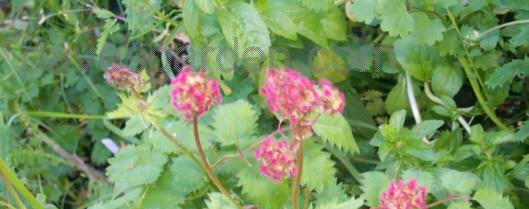Burnet (Sanguisorba officinalis, but also S. albiflora, S. annua, S. canadensis, S. menziesii, S. minor, S. obtusa, S. occidentalis, and S. tenuifolia) is a European species that was brought to the Americas… A member of the rose family, it is common across the South, up the Atlantic states, and into Canada. Grown as a flower, an herb and a salad plant, it is an important yet relatively unknown plant today. The cultivated flowers are best for wine, yet wild flowers may be used for a lesser quality product. When collecting wild burnet, make absolutely sure you know what you are harvesting. Do not confuse burnet with burnet saxifrage, which is Pimpinella saxifraga. If there is even the slightest doubt, have a nurseryman or botanist confirm their identity or else make another wine.
Use only the flower heads in making the wine. All greenery should be removed. The flowers, regardless of their color, make a white wine.
Burnet Wine
3 qts burnet flowers, destemmed
1-3/4 lbs granulated sugar
1 can Welch’s 100% White Grape Juice frozen concentrate
2 lemons
1 orange
1/4 tsp grape tannin
6-1/2 pts water
1 tsp yeast nutrient
1 pkt general purpose wine yeast
Set half-gallon of water on stove in stock pot to boil. Meanwhile, wash flowers, remove stems and set aside in primary. Collect zest from lemons and orange and add to primary. Squeeze juice from citrus and store in refrigerator. When water boils, pour over flowers and stir. Cover primary and set aside for two days. On that day make a yeast starter and, separately, bring remaining water to boil and dissolve sugar in it. Set aside to cool to lukewarm. At that time, strain off flowers and zest and discard. Combine flower water with sugar water in primary. Add grape concentrate and citrus juice, grape tannin and yeast nutrient. Stir well and add yeast starter.
Cover with sanitized cloth and set aside in warm place to ferment. When vigorous fermentation slows (7-10 days), check specific gravity. If at or under 1.010, transfer to secondary and fix airlock. If wine does not clear in 30 days, add one teaspoon pectic enzyme to clean secondary and rack wine into it. Reattach airlock and wait additional 30 days. Rack, add one crushed and dissolved Campden tablet and 1/2 tsp dissolved potassium sorbate. Wait 10 days, sweeten to taste and set aside an additional 30 days. Rack into bottles and age at least 6 months.
Recipe by Jack B. Keller Jr. check out his awesome & detailed winemaking page [here]


It’s truly a great and helpful piece of information. I am glad that you simply shared this helpful info with us. Please stay us up to date like this. Thanks for sharing.